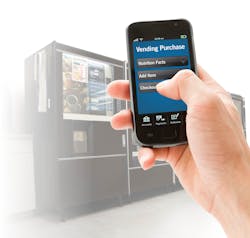Mobile payments are a great opportunity for the vending industry. By adding them to vending machines, the operator has a chance to enter the future of payments and reach the consumer in an entirely new and engaging way. There are many mobile payment options for today’s vending machines and the specifics of each solution are represented in a chart on page XX. The vending machine mobile payment solutions are based on different technologies and views within the mobile payment arena, but each works to satisfy the end user and provide the operator with more sales.
Win over the consumer first
The experience and perception of the consumer is a major factor in mobile payment solution success. “Most consumers have a smartphone and they will choose the mobile payment solution that works best for them and fits their needs,” said Patrick Richards, CPI. This means mobile payment options on vending machines have to be easy to use, easy to setup and easier than paying with cash/card. “Incentives don’t hurt either,” Richards added.
The first round of near field communication (NFC) wallets -- such as Google Wallet and Softcard (formerly Isis) -- had some challenges which kept them from being adopted by the mainstream consumer. Only some cellular phones had NFC. If it did, then only certain mobile wallets and credit cards were allowed on specific cellular carrier plans. It wasn’t universal or prevalent in retail. Payment security was also a concern with many consumers. Since that point, NFC mobile payment options have expanded and the original consumer concerns have been addressed. In September of 2014, Apple joined the NFC-based mobile wallet category with its introduction of Apple Pay, the latest mobile payment option.
Richards believes the release of Apple Pay has and will change the mobile payment market because NFC has benefits over other technologies such as Bluetooth low energy (BLE) and cloud-based payment systems due to the broader proximity requirements and time-tested secure payment system. “NFC doesn’t need to be close to the vending machine,” explained Richards. “And while there is a big push for cloud-based payments to avoid credit card transaction fees, I don’t think consumers are going to want to enter their bank account number which would be required.” He argues consumers already know and trust the traditional credit system.
BLE gives demographics
While NFC certainly has its advantages, many in the industry believe other technologies present a better approach to mobile payments. Lori Salow Marshall, founder and CEO of BYNDL, Inc., sees a phone to machine connection in one of two ways. “One party is the tag and the other party is the tag reader,” she said. In the case of NFC, the smartphone is the tag and the tag reader has to be attached to the vending machine. Readers tend to be costly compared to tags. A less expensive option might be using a QR code on the machine or BLE device in the machine as the tag and the consumer’s smartphone as the “tag” reader. This format also has the advantage of allowing demographic information to be recorded, which isn’t available with most NFC systems. “NFC runs on the payment rails - meaning merchants aren’t allowed to see consumer data,” said Marshall. “[Using QR codes or BLE], demographic information the consumer has agreed to allow is viewable,” explained Marshall. “We marry that to what happened at the machine - what was bought - and you can get a lot of valuable data.”
The lower cost of mobile payment options that use BLE technology could also help increase the number installed on machines -- driving usage by the consumer up further, argues Paresh Patel, creator of PayRange. “Our system allows operators to get cashless payment into all machines rather than just the top 5 percent,” said Patel “We’ve seen phenomenal interest,” he added. Young people aren’t carrying cash, but many have a smartphone. “It doesn’t matter how well you drive demand to the machines if at the end of the day some people will not be able to pay,” he said. Patel believes mobile payment options should be quick and easy for the consumer and cross over to different industries in order to create more value to the end user.
Future-proofing technology
Vending technology needs to be able to handle future innovations, so some companies are “future-proofing” their hardware by allowing both NFC and BLE communication methods at the point-of-sale. For example, USA Technologies has a proprietary mobile application that the consumer can download which uses BLE to connect the end user’s mobile device with a vending machine. However, USA Technologies also allows consumers to pay with NFC-enabled mobile wallets, such as Apple Pay or Google Wallet, that they may already have on their mobile device.
“We are working with different companies to integrate features and functionalities into our mobile payment options,” said Maeve McKenna-Duska, vice president of marketing at USA Technologies (USAT). She believes this is the best way to grow mobile payments.“We work together in this space to allow the operator to choose their preferred program.”
Besides BLE and NFC technologies, USAT also partners with other mobile payment applications such as those using QR codes.
Accepting multiple payment options creates value to the customer, as it lets the end user choose his or her method of payment. Likewise for the vending operator, it means more industry partnerships and potential around mobile payments solutions. “We don’t see ourselves as competitors with other mobile technologies,” said Lance Ellsworth, co-founder of AirVend. Instead, Ellsworth sees the consumer as the post all manufacturers should be working around. “Customers all pay with different mobile apps and our hardware needs to accept every type,” he said. It also needs to promote different payment options at the point of sale. “We have the ability to educate the consumer about their payment options,” said Ellsworth, which might include different types of mobile payment as well as cash. “By partnering with other mobile payment providers, we give the consumer the option of choosing how they want to pay.”
David Grano, CEO of Vendscreen, believes there needs to be one common application or mobile payment option for customers at the machine. “Consumers don’t want to have five or ten mobile apps on their phone,” said Grano. “So we are big believers in the industry coalescing around one common app.” Despite this belief, however, Grano notes that that may be impossible with the large number of entrants into the mobile payment field. He predicts that in the next twelve months there will be two to three new mobile payment solutions available in vending, and it’s the responsibility of the technology companies to support these new entrants. Although one mobile app would be beneficial to the consumer, technology providers need to design hardware that will accept the many forms of mobile payments consumers have now and in the future. “We need to future-proof the technology for the operator,” he said.
Good for consumers and operators
The convenience of one mobile wallet or application accepted at multiple places is an important aspect of the evolution of payments in general. However, is there a way to also allow companies to increase their own brand awareness? Nayax thinks so. “We are trying to connect the machines with the operators in order to help the operator bring in more customers,” said Keren Sharir, program and marketing manager at Nayax, which in the past, sold card readers in the U.S. under the InOne brand.
Nayax is beta testing a mobile wallet that will be branded with the vending operator’s company name and offer loyalty rewards. “It will be better because consumers will see the operator’s brand and be able to associate the machine with the company,” said Sharir. She sees mobile payments as potentially replacing even credit and debit cards as the consumer’s preferred method of payment. “A few years ago we started to speak about cashless replacing cash -- that was before smartphones. Now everyone is using smartphones and I believe that will replace cashless,” she said.
Broader benefit of telemetry
Mobile is an important payment option for the future of vending and Anant Agrawal, CMO and co-founder of Cantaloupe Systems believes it should also be part of a larger business operations strategy. “Mobile is part of our cashless system along with the logistic management benefits,” said Agrawal. Operators will want to use telemetry and reporting in conjunction with mobile payments. One example is in paying different commission percentages based on the payment method used by the consumers. “Two-tier pricing can and should affect how much operators are paying in commissions,” said Agrawal. “Seed Cashless lets them set X percent for cash transactions and Y percent for cashless transactions, which includes mobile payments.”
The consensus among mobile providers is that a vending industry-only mobile option probably won’t work in the long run, but how the mobile device would best communicate with the machines is still up for debate. There are benefits to each system, so operators need to consider their needs now and in the future as well as what will work best for the next generation of mobile device users. Technology is a large part of life for most people, and bringing the vending machine up-to-date by adding mobile payment will propel it from last resort to the convenient unattended food provider that drove its initial inception.
Pay with social media
How valuable is social media? As consumers highly value the opinions of their friends and followers, social media can be a compelling marketing tool, which is why one mobile payment technology provider believes it’s better than credit. FanWise uses cellular data and WiFi to create a connection between the user’s smartphone and the machine. “FanWise leverages a behavior social media users already practice daily…posting to Facebook or Twitter,” said Brett Circe, FanWise president. “It provides the consumer with a cash value for their update that can be used to buy goods instantly at vending machines, driving more sales volume.” Demographic information from the social media account can be presented to the operator.
Secure consumer data
Guaranteeing a safe transaction at the vending machine is imperative. Consumers must feel safe using their mobile devices to pay when and if they don’t have cash. Each provider of mobile payment solutions in the vending segment has looked at how to best secure consumer data while offering the operator and consumer choice. Most providers use third-party processors and systems where the card number is replaced by a string of random numbers called tokenization. In both cases, the credit and debit card information is not physically stored in the device on the vending machine. That keeps the card information from being stolen. Securing payment data is an intricate industry, but look for Payment Card Industry or PCI compliance and ask questions about security to find out about specific protections.

Emily Refermat
Emily began covering the vending industry in 2006 and became editor of Automatic Merchandiser in 2012. Usually, Emily tries the new salted snack in the vending machine, unless she’s on deadline — then it’s a Snickers.
Emily resigned from Automatic Merchandiser and VendingMarketWatch.com in 2019 to pursue other opportunities.

Adrienne Klein | Contributing Editor
Adrienne Zimmer Klein is a freelance writer with a background in the vending, micro market and office coffee service industry. She worked as an associate editor and managing editor at Automatic Merchandiser and VendingMarketWatch.com from 2013 until 2017. She is a regular contributing writer at Automatic Merchandiser.





